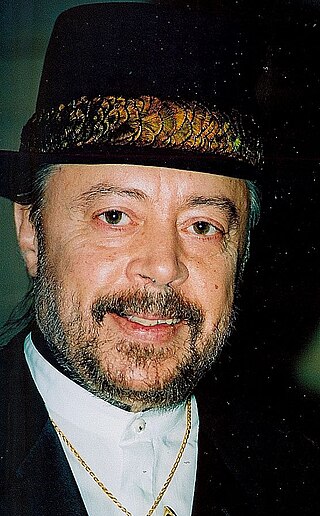
Sidney Joseph Bechet was an American jazz saxophonist, clarinetist, and composer. He was one of the first important soloists in jazz, and first recorded several months before trumpeter Louis Armstrong. His erratic temperament hampered his career, and not until the late 1940s did he earn wide acclaim. Bechet spent much of his later life in France.

Charles Frank Mangione is an American flugelhorn player, trumpeter and composer.

Coleman Randolph Hawkins, nicknamed "Hawk" and sometimes "Bean", was an American jazz tenor saxophonist. One of the first prominent jazz musicians on his instrument, as Joachim E. Berendt explained: "there were some tenor players before him, but the instrument was not an acknowledged jazz horn". Hawkins biographer John Chilton described the prevalent styles of tenor saxophone solos prior to Hawkins as "mooing" and "rubbery belches". Hawkins denied being first and noted his contemporaries Happy Caldwell, Stump Evans, and Prince Robinson, although he was the first to tailor his method of improvisation to the saxophone rather than imitate the techniques of the clarinet. Hawkins' virtuosic, arpeggiated approach to improvisation, with his characteristic rich, emotional, and vibrato-laden tonal style, was the main influence on a generation of tenor players that included Chu Berry, Charlie Barnet, Tex Beneke, Ben Webster, Vido Musso, Herschel Evans, Buddy Tate, and Don Byas, and through them the later tenormen, Arnett Cobb, Illinois Jacquet, Flip Phillips, Ike Quebec, Al Sears, Paul Gonsalves, and Lucky Thompson. While Hawkins became known with swing music during the big band era, he had a role in the development of bebop in the 1940s.

Gerald Joseph Mulligan, also known as Jeru, was an American jazz saxophonist, clarinetist, composer and arranger. Though primarily known as one of the leading jazz baritone saxophonists—playing the instrument with a light and airy tone in the era of cool jazz—Mulligan was also a significant arranger working with Claude Thornhill, Miles Davis, Stan Kenton, and others. His piano-less quartet of the early 1950s with trumpeter Chet Baker is still regarded as one of the best cool jazz ensembles. Mulligan was also a skilled pianist and played several other reed instruments. Several of his compositions including "Walkin' Shoes" and "Five Brothers", have become standards.

The alto saxophone is a member of the saxophone family of woodwind instruments. Saxophones were invented by Belgian instrument designer Adolphe Sax in the 1840s and patented in 1846. The alto saxophone is pitched in the key of E♭, smaller than the B♭ tenor but larger than the B♭ soprano. It is the most common saxophone and is used in popular music, concert bands, chamber music, solo repertoire, military bands, marching bands, pep bands, carnatic music, and jazz.

Nathaniel Carlyle Adderley was an American jazz trumpeter. He was the younger brother of saxophonist Julian "Cannonball" Adderley, whom he supported and played with for many years.

Laurdine Kenneth "Pat" Patrick Jr. was an American jazz musician and composer. He played baritone saxophone, alto saxophone, and Fender bass and was known for his 40-year association with Sun Ra. His son, Deval Patrick, was formerly governor of Massachusetts.

David "Fathead" Newman was an American jazz and rhythm-and-blues saxophonist, who made numerous recordings as a session musician and leader, but is best known for his work as a sideman on seminal 1950s and early 1960s recordings by Ray Charles.
James Garland Riggs is an American saxophonist in classical and jazz idioms, big band director, collegiate music educator, and international music clinician. He is also a University of North Texas Regents Professor Emeritus.

Ellington at Newport is a 1956 live jazz album by Duke Ellington and his band of their 1956 concert at the Newport Jazz Festival, a concert which revitalized Ellington's flagging career. Jazz promoter George Wein describes the 1956 concert as "the greatest performance of [Ellington's] career... It stood for everything that jazz had been and could be." It is included in the book 1001 Albums You Must Hear Before You Die, which ranks it "one of the most famous... in jazz history". The original release was partly recreated in the studio after the Ellington Orchestra's festival appearance.
Cecil B. Leeson, a musician and teacher, was widely credited with establishing the saxophone as a legitimate concert instrument in the U.S.

Henry "Skipper" Franklin is an American jazz double bassist.

The Magic City Jazz Orchestra (MCJO) is an American jazz ensemble which was founded in 1999 as a spin-off of the SuperJazz Big Band by Birmingham, Alabama jazz pianist and vocalist Ray Reach. The mission of the group is to "...perform and record big band jazz music written by well known but under-recorded jazz artists."
Earle Warren was an American saxophonist. He was part of the Count Basie Orchestra from 1937.
Salvatore Nistico was an American jazz tenor saxophonist.

Charles Davis was an American jazz saxophonist and composer. Davis played alto, tenor and baritone saxophone, and performed extensively with Archie Shepp and Sun Ra.
José María De León Hernández, known professionally as Little Joe, is an American tejano performer who was born and raised in Temple, Texas.

On Stage is an album by the Gerald Wilson Orchestra recorded in 1965 and released on the Pacific Jazz label.

Gerry Mulligan and the Concert Jazz Band on Tour is a live album recorded by American jazz saxophonist and bandleader Gerry Mulligan featuring performances recorded in California, Berlin and Milan 1960 which were released on the Verve label. In the CD era it has been superseded by The Complete Santa Monica Concert

Gerry Mulligan and the Concert Jazz Band at the Village Vanguard is a live album by jazz saxophonist and bandleader Gerry Mulligan featuring performances recorded at the Village Vanguard in late 1960 which were released on the Verve label.















